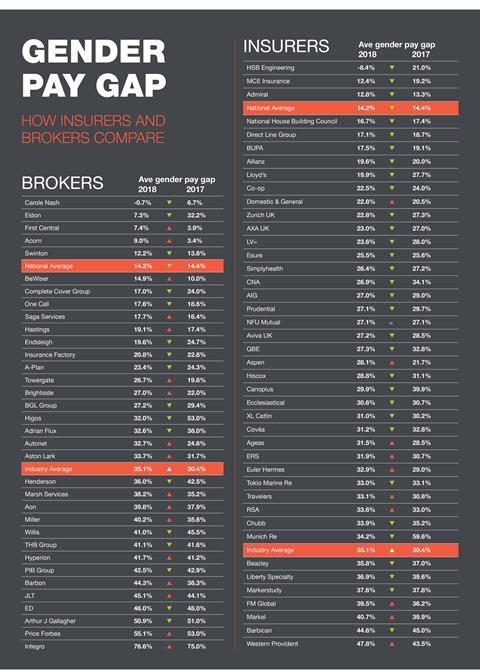The average insurance industry pay gap between the genders has worsened over the past 12 months. Insurance Times analysis ranks 34 brokers and 42 insurers and assesses whether they are paying women more or less than last year

Over the past two years, the insurance industry has analysed and reported on the difference in pay between men and women. But while 70% of insurers and half of brokers have reported an improvement in their gender pay gap, the industry as a whole has declined.
The average gender pay gap across the industry had risen to 35.1% at the end of the 2017/18 financial year, up from 30.4% a year earlier. This compares with a national average of 14.2%.
But despite this worsening position, CII people engagement director Tali Shlomo says it is more important to focus on the longer-term changes the industry needs, rather than short-term fluctuations.
“Our sector and our profession is lagging behind [the rest of the country], and some insurance organisations are seeing a slight drop [in their gender pay gap], while others are seeing a slight increase,” she says.
“It only takes one senior woman to
leave an organisation for the data to start dropping, and we can see that happening with actually a 5% drop in the number of women in the C-suite [in insurance].
“I have always said it will take several years to narrow the gender pay gap in insurance, and what is more fascinating for me is to look at the root cause of the problem, not just these numbers in isolation.”
Shlomo says the CII is focusing on the root cause of the problem that will have the biggest long-term affect on the gender pay gap.
Only by looking at that, she says, will the industry be able to assess why it is in the position that it is, and what actions can be taken to rectify it.
“It is interesting and useful to know that the gender pay gap is still on people’s radar, it is still on the senior management team’s radar, and that action is being taken.
“The fact that some organisations’ gender pay gaps are increasing or decreasing by three or four percentage points is fine, but the real question is about what actions are being taken to close that gap over the longer term.”
Improvements in recruiting
Recruitment is one area where the CII is having success in changing mindset over gender diversity.
Shlomo says recruitment practices are changing, and recruitment panels need to be both gender and ethnicity-balanced, while advertising of the role needs to include more part-time and flexible recruitment.
“We won’t see the benefit of this overnight – it will take a number of years – but most of this is about shifting the mindset, and that takes a while to achieve because it is behaviour driven.
“But the fact that we have started to look at recruitment practices ticks a lot of boxes. With millennials joining the workforce, the first thing they look for is diversity and inclusion, which includes the gender pay gap, and soon, the ethnicity pay gap.
“And if they find that there is a large gender or ethnicity pay gap, then they will want to know what the organisation is doing about it.”
Shlomo says that this fresh approach to recruitment has meant the CII seeing more candidates for a role so it they can ensure it has seen a fully diverse range of potential new employees.
“If I don’t see a diverse range of candidates from our recruiters, I will push back,” she says. “So sometimes we will have to go through three or four rounds of candidates [before we achieve that broad range of diversity] but that has been a real change in mindset.
“We always hire on merit, but the fact we have gone through a process where we have challenged the thinking, not just with recruiters, but also our hiring managers, is very important.”
Internal practice
But once the recruitment practice has been improved, attention needs to turn to internal practice, which Shlomo says has been a problem for the insurance industry for some time. For example, women are not often enough identified for taking on challenging or high-profile projects
“The tendency is to say they are not ready, but it is about being brave and giving a stretch objective or visible project to women, because usually it is given to the people who usually have these projects, which is usually men.
“It is all about giving people the confidence and the support to take these on. Mentoring is a big part of that, and the CII and other organisations are part of the 30% Club programme, which is mentoring for women.
“We also have informal mentoring programmes, and sponsorship is also important, because it is about a senior person in the organisation supporting women in being visible in our profession.”
Sponsorship is an area where AXA is focusing efforts to close its gender pay gap, and AXA UK group HR director Lucinda Charles-Jones says the programme is already paying dividends for the insurer’s female staff.
“We’ve launched a leadership development programme for our high-potential female employees, with each participant sponsored by one of our executive leaders,” she says.
“As a result, several women have already been promoted or taken part in major projects.
We have also been participating in the 30% Club cross-company mentoring scheme where women can learn from leaders both within and outside the insurance sector.”
Downloads
Gender pay gap
PDF, Size 0.3 mb












































No comments yet